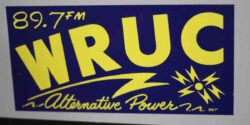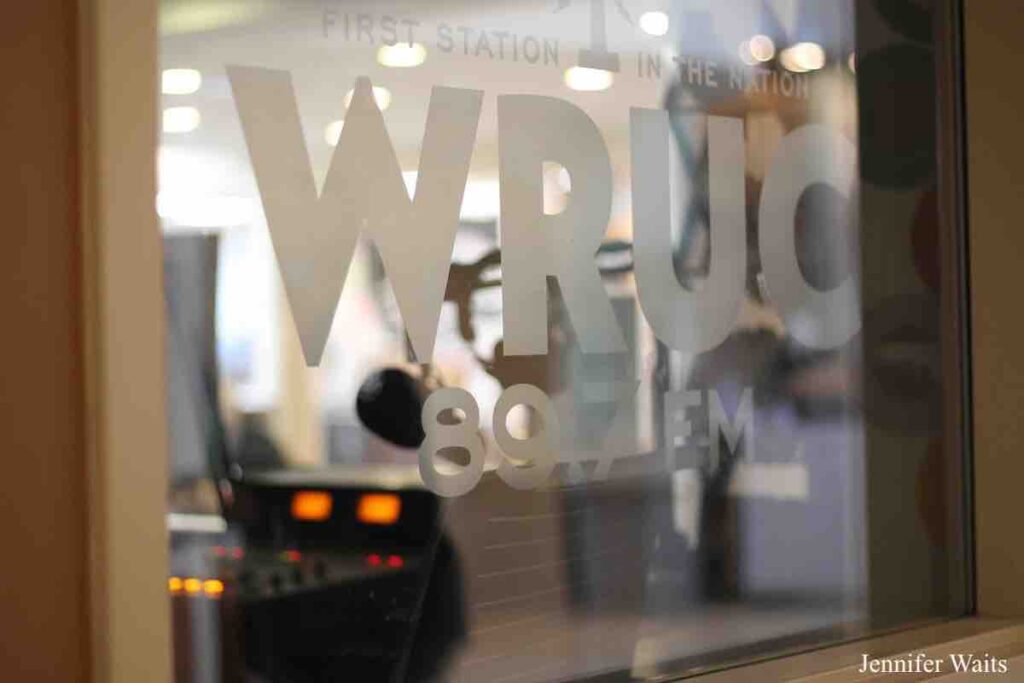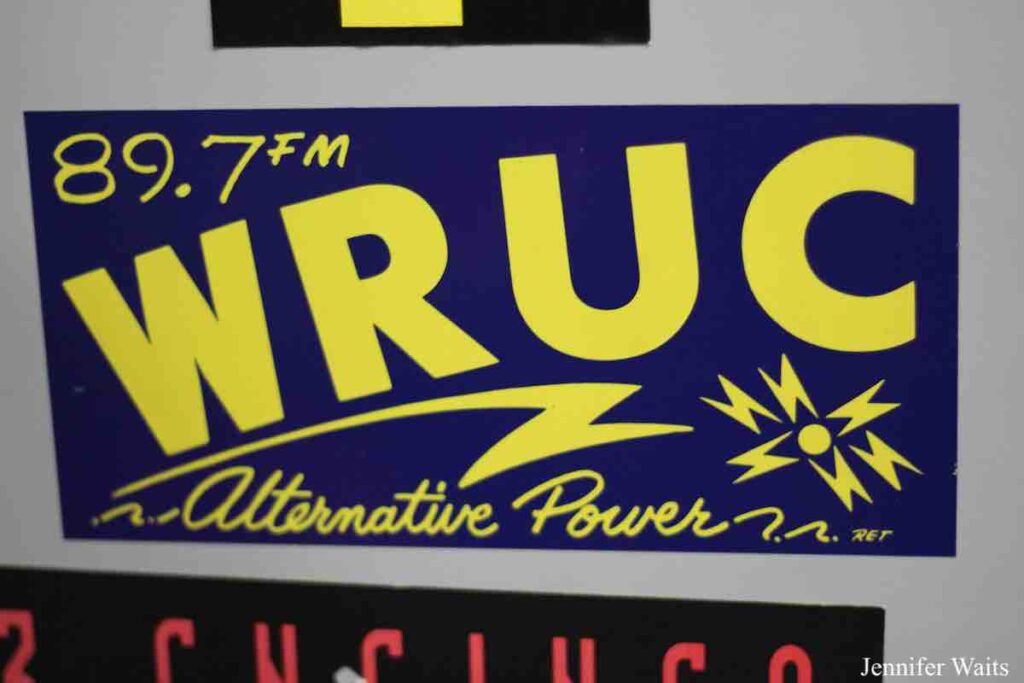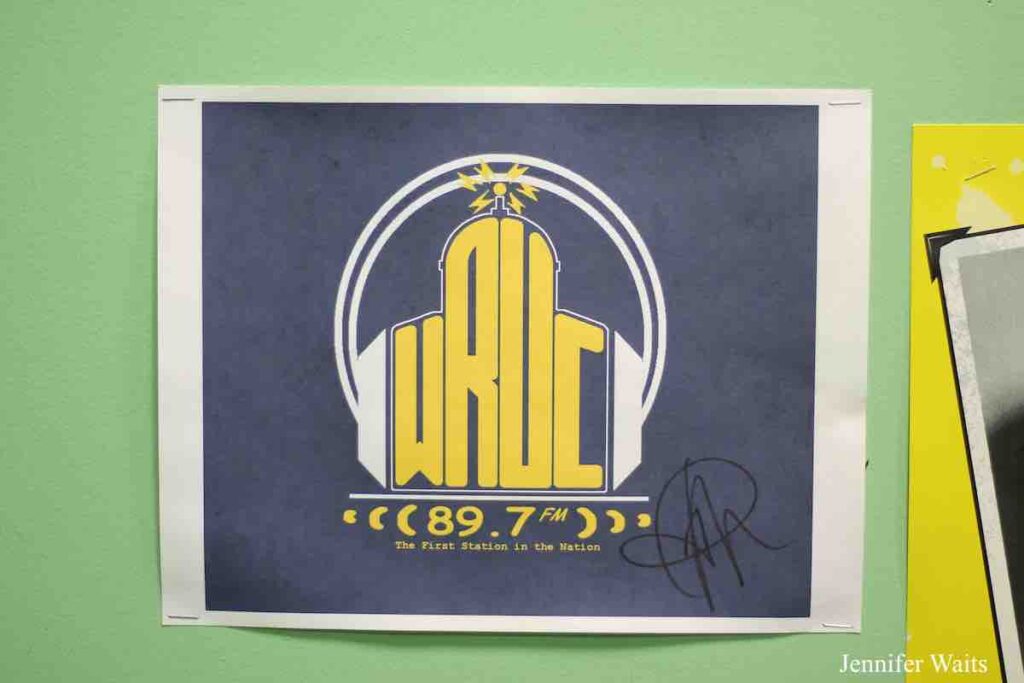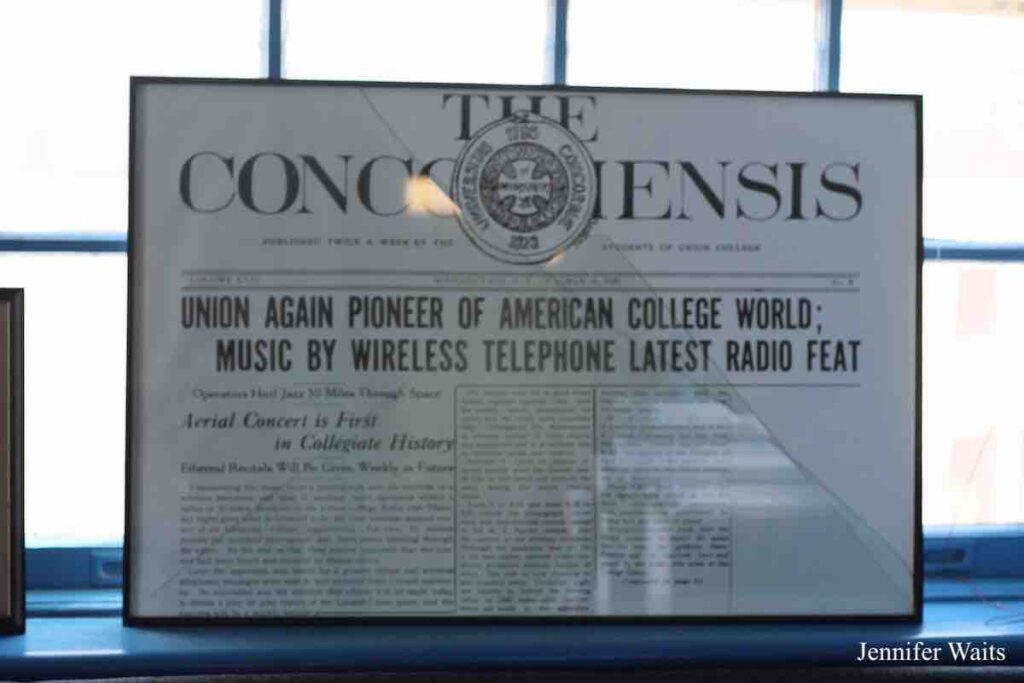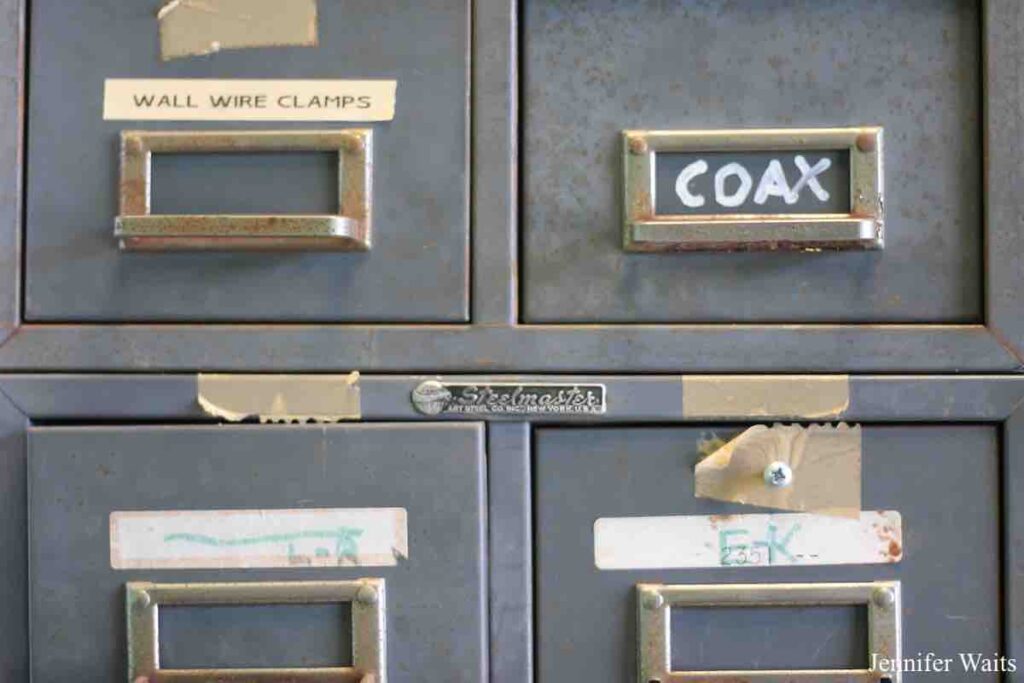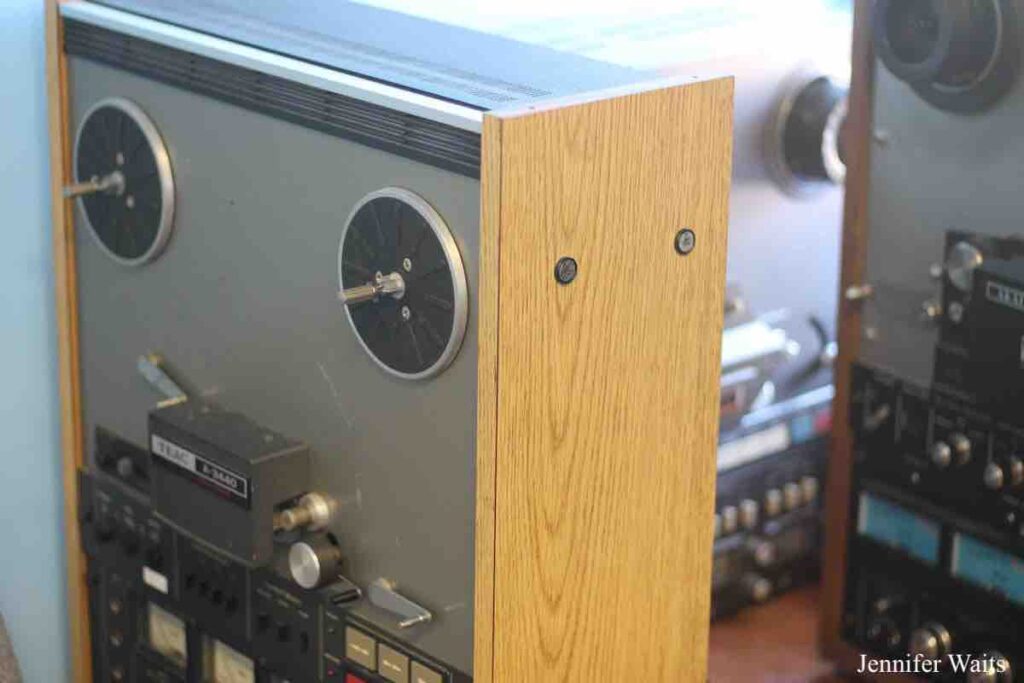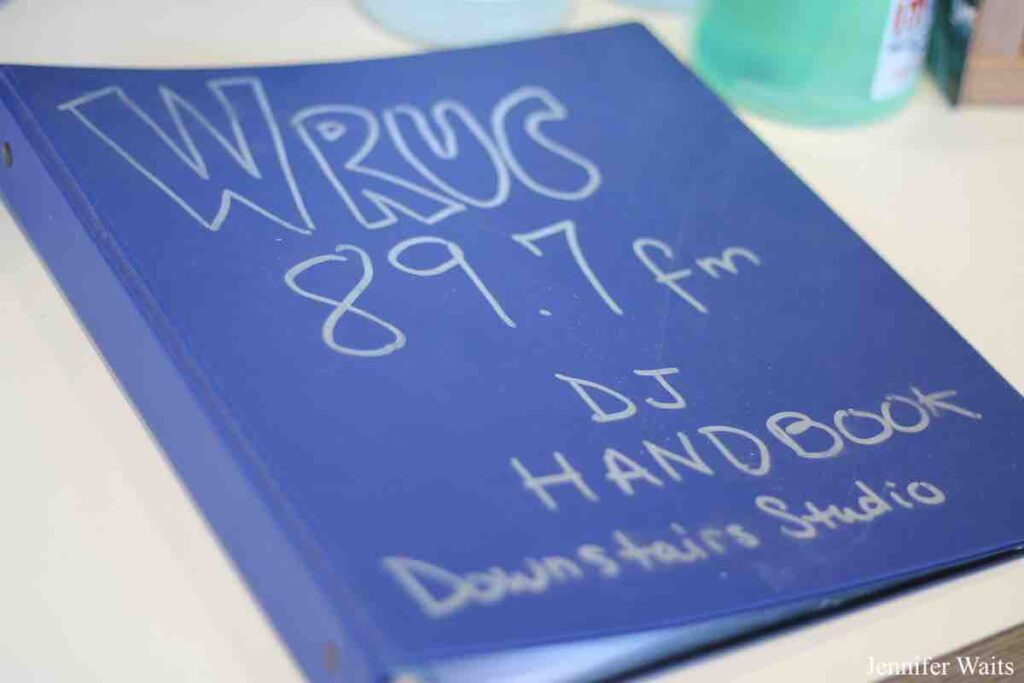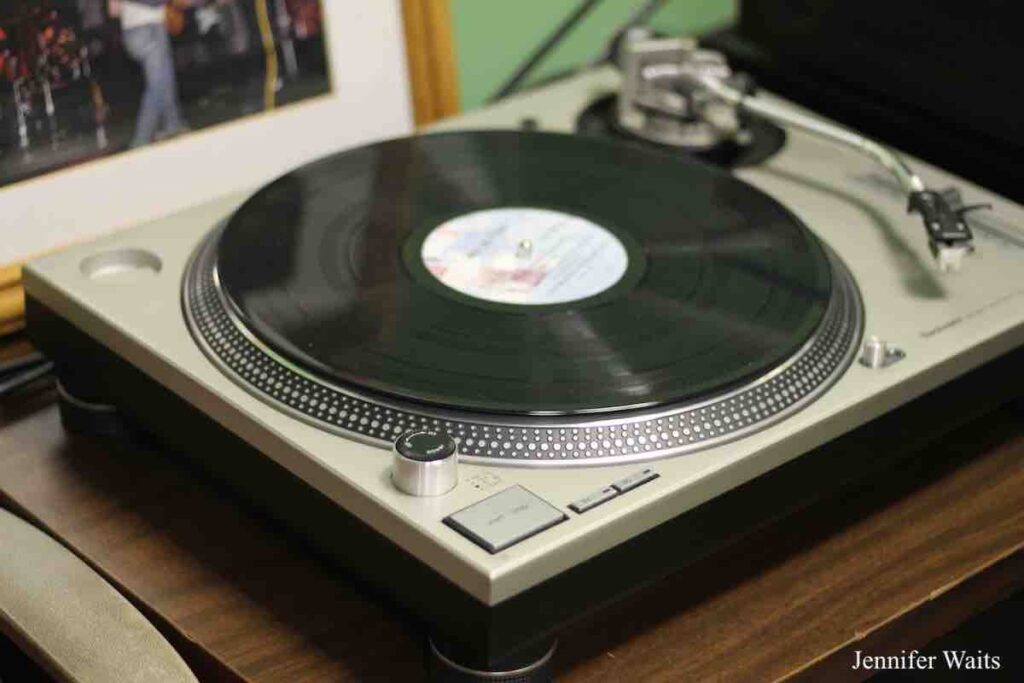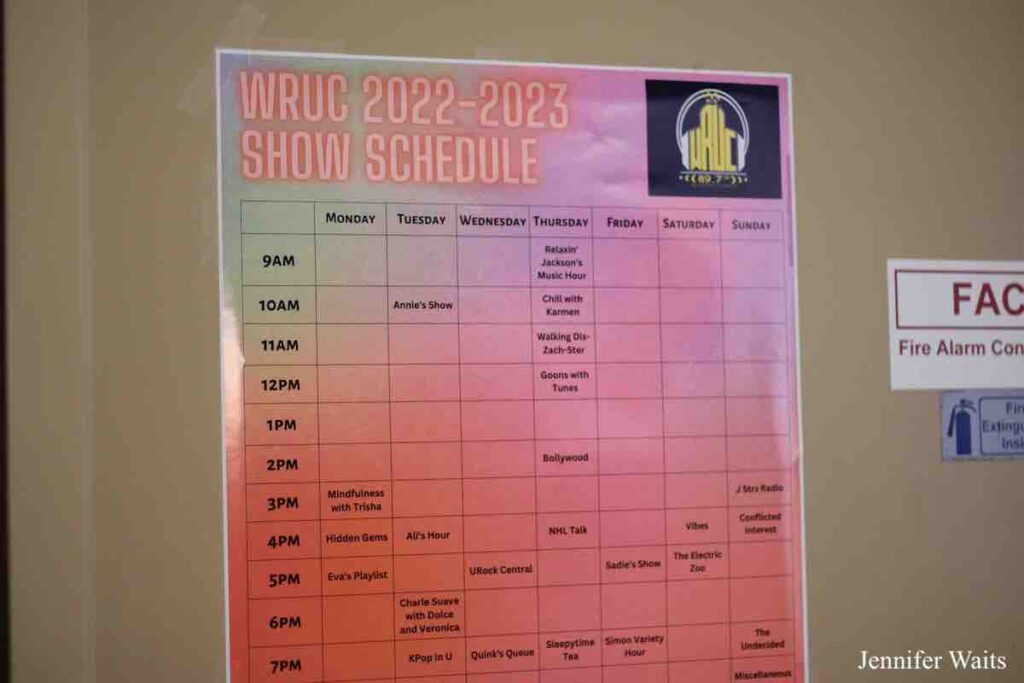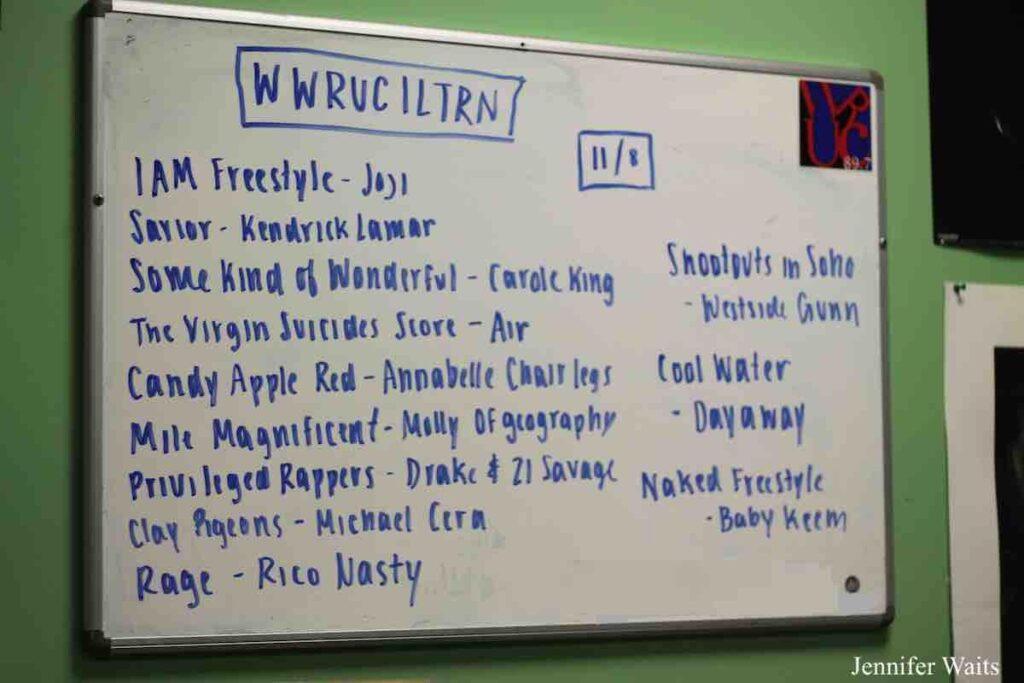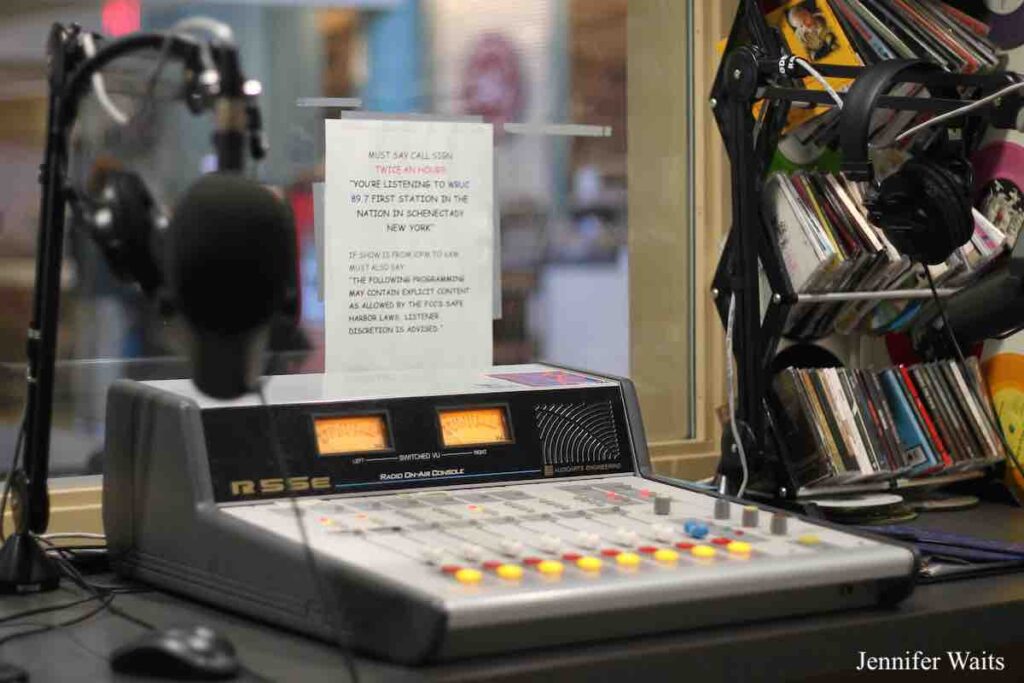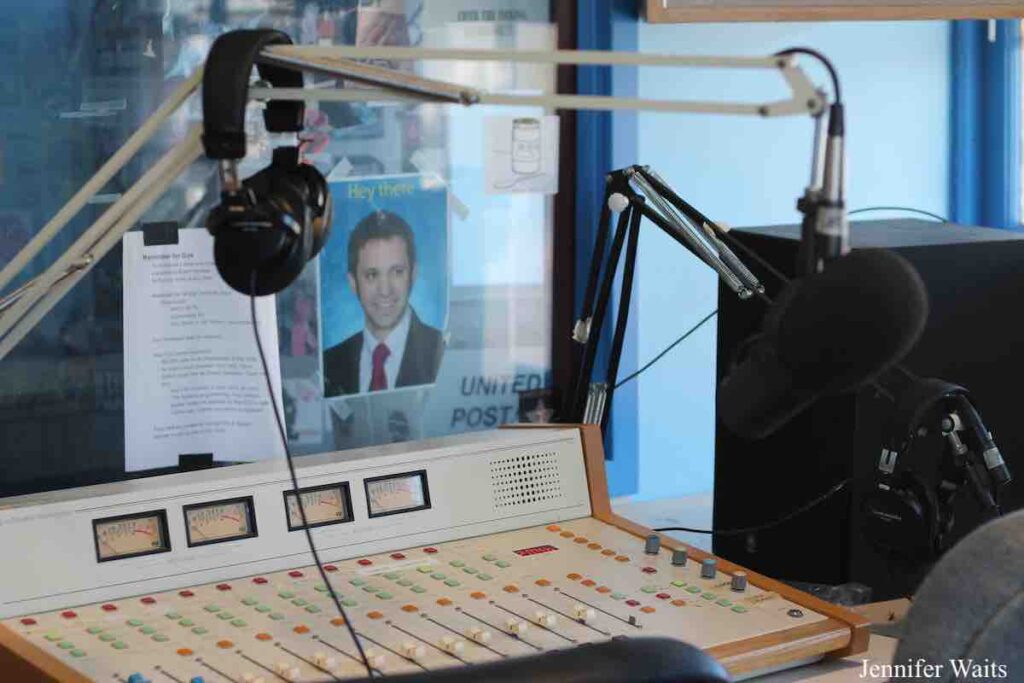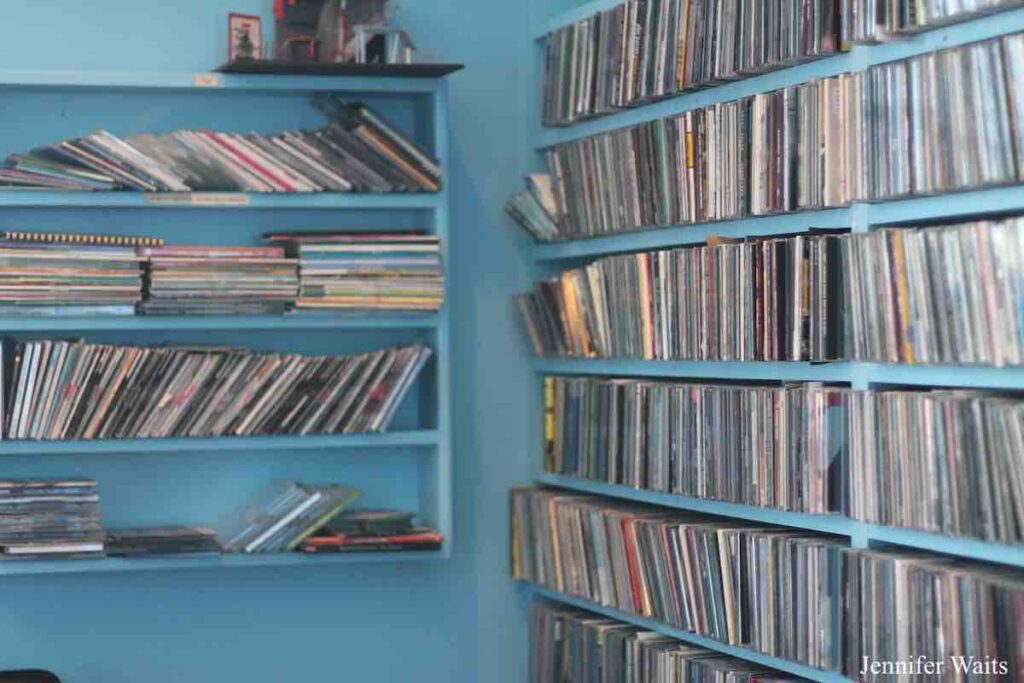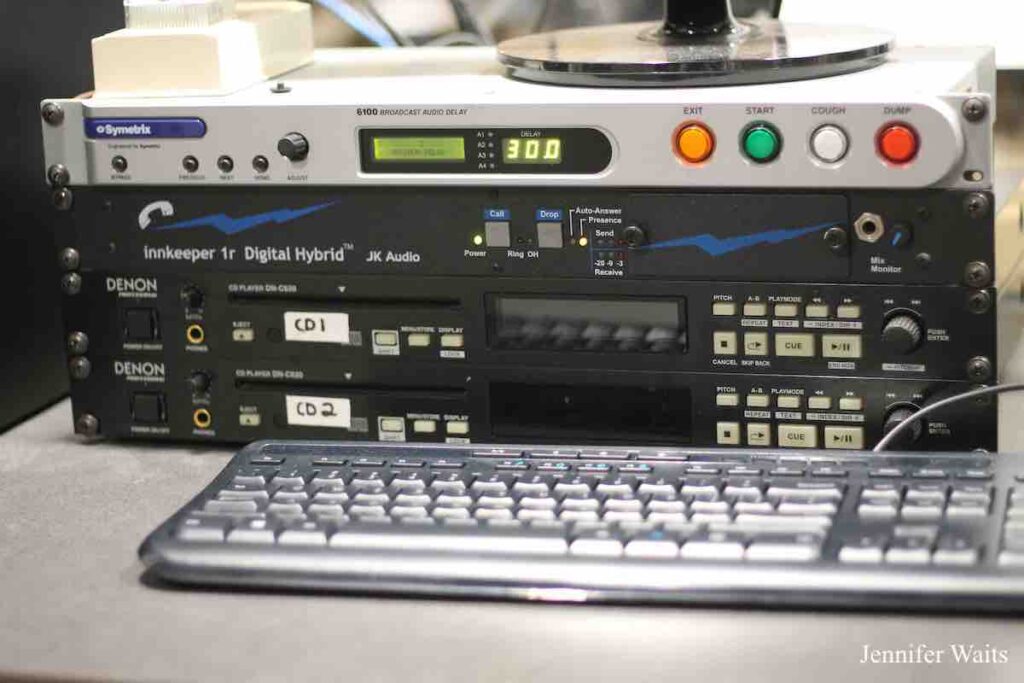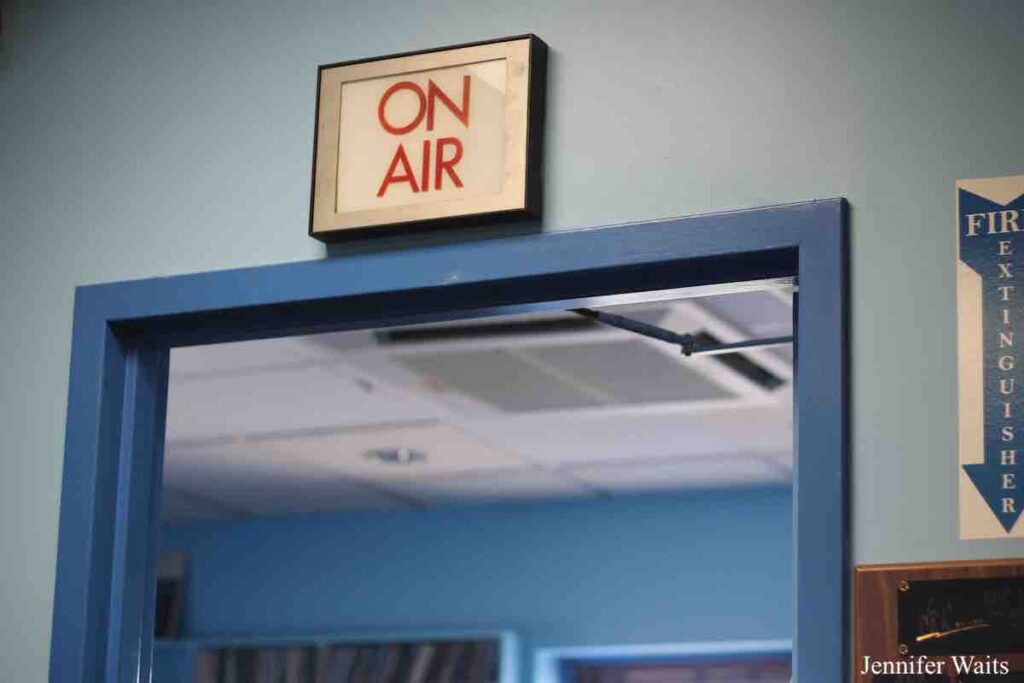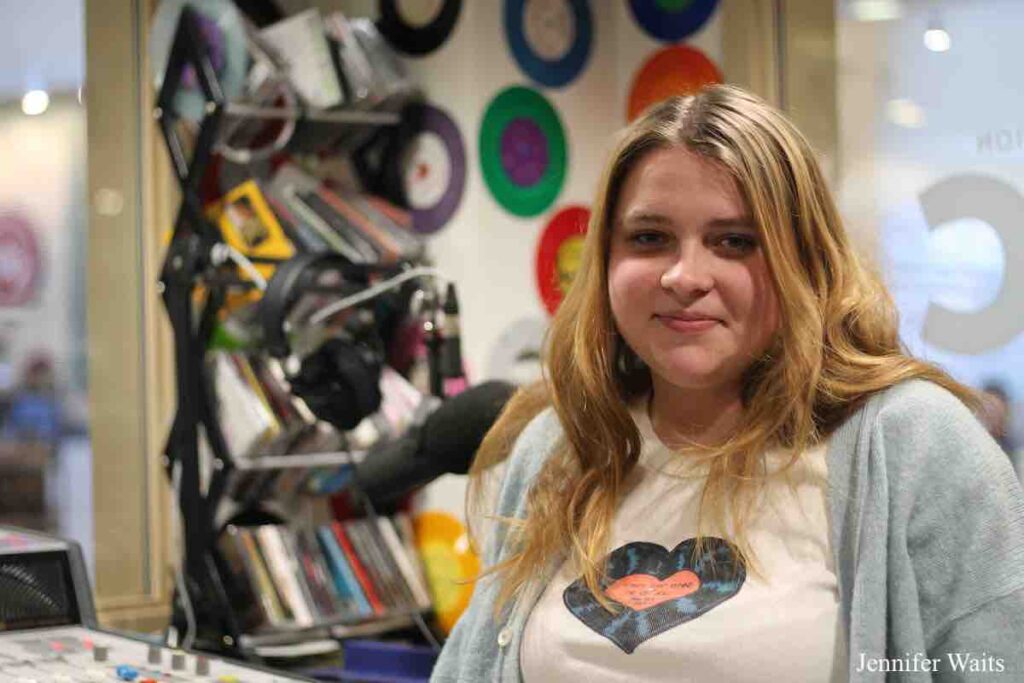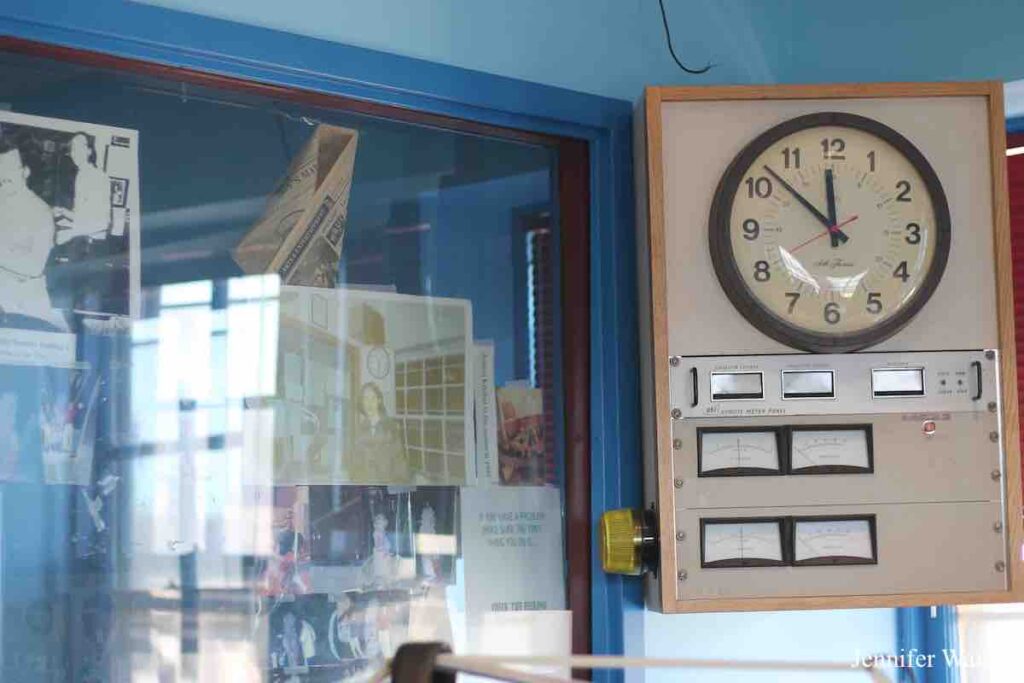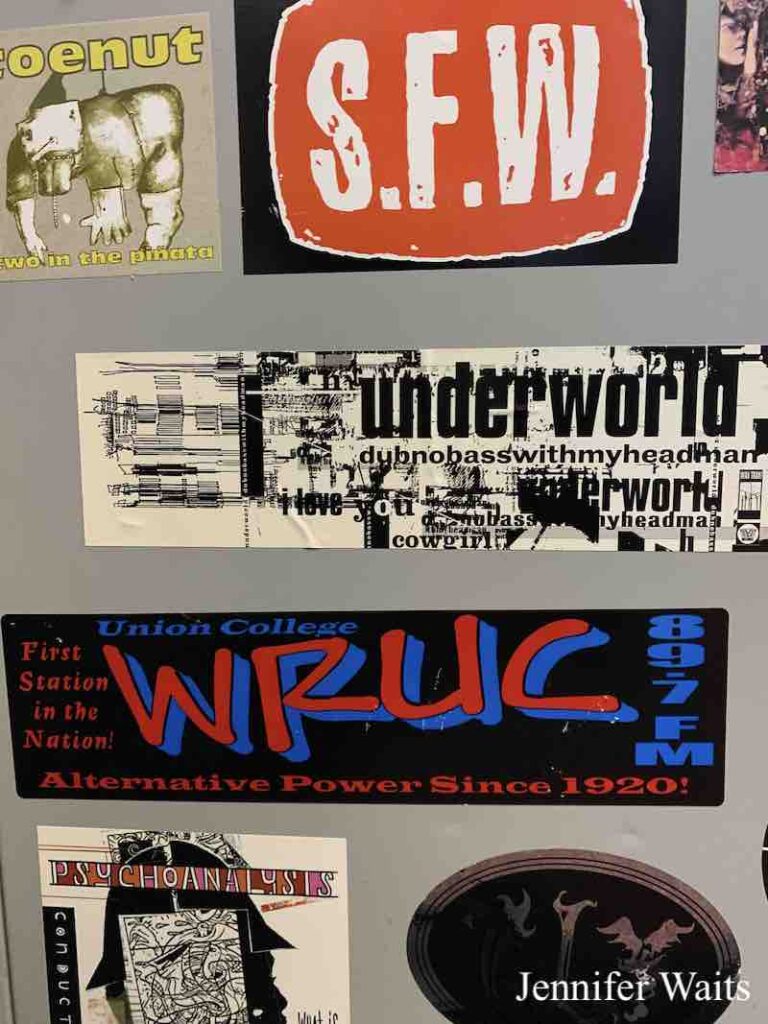To say that my visit to college radio station WRUC 89.7 FM at Union College in Schenectady, New York was eagerly anticipated is an understatement. Rumored to be the “first” commercial college radio station, its predecessor stations have a fascinating history, making Union College an important stop for every college radio historian. Lucky for me, my trip to the school in November, 2022 included a visit to Special Collections and Archives at Union College’s Schaffer Library, which contains an enviable array of materials documenting the early days of student radio in the 1920s and beyond.
Snapshot of WRUC’s History
Like many college radio stations circa 2023, WRUC has had quite the journey, with many twists and turns along the way as far as its role on campus and its method of transmission. Currently broadcasting over 89.7 FM, WRUC has been a licensed FM station since 1975. Prior to that, student radio at Union College was transmitted by carrier current (starting in 1941, with call letters WRUC eventually adopted). But the early radio activities at Union College, beginning with experiments and amateur broadcasts, are especially fascinating and worthy of a much longer article.
Union College Radio Club Began in 1915
Radio experiments were happening at Union College since radio’s earliest days and the first campus Radio Club began in 1915, according to “Radio Broadcasting at Union College: A Brief History,” written by Rowan Wakefield in 1959. But what happened in 1920 is an important part of WRUC’s long-time branding as “first” in the nation. Its current website states, that WRUC “is the first commercial college radio station in the country.” While this specific claim has been debated (the first licensed broadcast station at Union was called WRL and was very short-lived), the early radio activities by students at Union College are impressive and worthy of more attention by radio scholars.
Union College Radio Club’s First Music Concert over Radio in 1920
As was the case with other early broadcasters, Union College’s Radio Club began with experiments over amateur radio. Significantly, on October 14, 1920, students in the club broadcast a short concert of music over the radio. In a piece previewing this event a few days prior, the student newspaper wrote:
If for the next week you hear noise a thunder every time you try to phone, you know the electric jazz experts are tuning up. And they are some jazz experts with high powers spark discharges. Starting next Thursday night, the radio club will give a concert via radio…This will be a weekly habit. If at some future time you have a dance on hand and your jazz artists fail you, call up 2 A D D tell them your trouble and if you’ve got a hairpin, a wire, a coil or two and a phone you will have al the music you wish via radio. (Concordiensis, October 12, 1920)
Following the successful first radio concert, headlines in the Concordiensis proclaimed, “Aerial Concert is First in Collegiate History” and “Ethereal Recitals Will be Given Weekly in Future.” An accompanying article states, “Transmitting the music from a phonograph into the receiver of a wireless telephone and then to amateur radio operators within a radius of 50 miles, members of the Union College Radio Club Thursday night gave what is believed to be the first wireless musical concert of an American college organization.” The paper reported that “vocal and instrumental records” were played.
The Role of Radio Prodigy Wendell W. King
Another notable aspect of this early broadcast is that the amateur station call letters used, 2ADD, were those of radio prodigy Wendell W. King, who started his own amateur station at the age of 12 and was “the first black student to attend Union for a significant length of time,” according to an article in the Encyclopedia of Union College History. The article points out that, “King had been involved with amateur radio since 1911 and may have been the most technically proficient student connected with early Union radio; he had already been president of the Troy Amateur Radio Club, had served in the Army Signals Corps, and had worked for the radio section of General Electric.” A profile of King in Union College Magazine outlines his achievements and also his “complicated time on campus.”
Experimental Station 2XQ and Continued Music Broadcasts
The Radio Club at Union College continued to do regular Thursday night music broadcasts over amateur radio and over its experimental station 2XQ (which it received a license for in 1919) and received letters from listeners who wrote in to report that they had heard and were enjoying the transmissions. In addition to those weekly broadcasts, the club did various “stunts,” including outfitting a baby carriage with a radio set. Radio Church services were also broadcast, including hymns played over a phonograph and “songs by a college quartet,” according to a report in the Schenectady Gazette on May 12, 1921. Another accomplishment in May 1921 was “the wireless transmission of the junior ‘prom’ music…which was the signal for hundreds of dances in this section of the country,” wrote the Schenectady Gazette. In advance of the prom, the Union College student newspaper Concordiensis reported that “The music of Ford Dabney’s Syncopated Orchestra of Ziegfield Midnight Frolic fame will be heard as far west as Nebraska and by ships far out at sea.” The event was an overnight affair, going from 10:30pm until 6am.
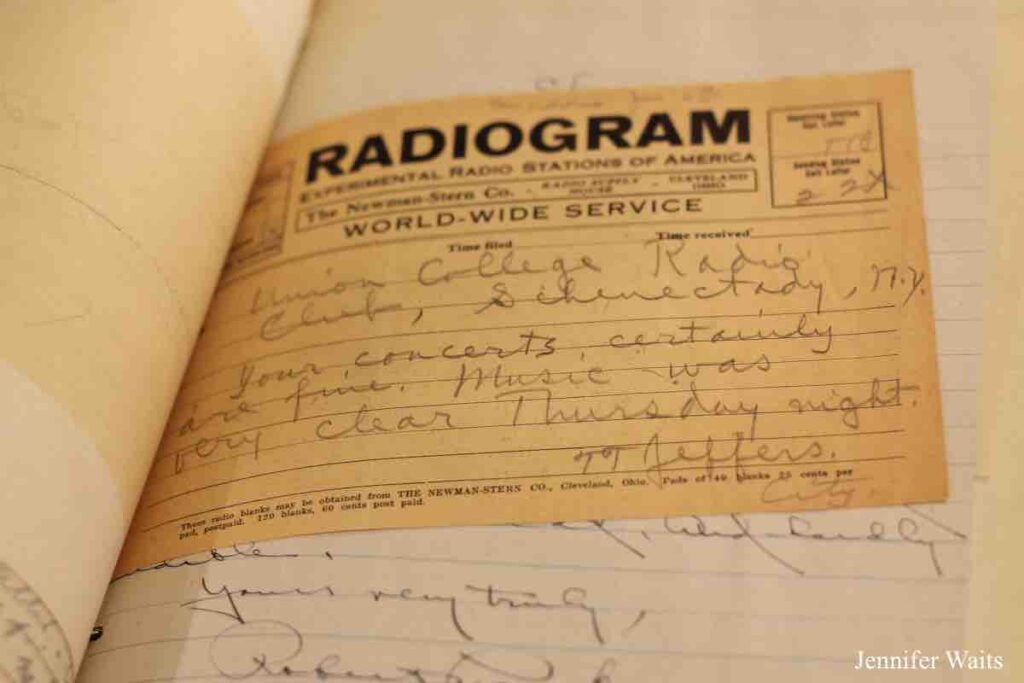
It’s difficult to ascertain if this was the first Radio Club on a college campus to regularly play music over the radio. Other stations had broadcast music over wireless prior to that time, but it’s unclear if this was happening with undergraduate students at the helm, as was the case at Union College. One very early example of music broadcasts over amateur radio took place at The Herrold College of Engineering and Wireless, which launched in San Jose, California in 1909. John Schneider writes, “Once [Doc] Herrold realized he had an audience of eager radio experimenters, he began to entertain them. He would discuss news items and read clippings from the newspaper, or play records from his phonograph. This got to be a more and more important part of the school’s operations, and regular programs were heard from the station as early as 1910.”
Broadcast Station WRL
In addition to these early broadcasts, Union College was one of the first colleges to obtain a limited commercial license to operate a broadcast station. The license for WRL was issued in March, 1922 and was held by Union College until 1924. Only a few other stations operating at colleges or universities obtained this type of broadcast license earlier, including University of Minnesota, and University of Wisconsin (both in January, 1922). After the WRL license expired, students at Union College did not run a broadcast station until launching an AM carrier current station in 1941.

100 Years Later: The State of WRUC in the 2020s
While the history of WRUC has been documented and celebrated, the station’s present state was more nebulous to me prior to my visit. The program schedule on the website was out of date and the internet stream was down. Social media had also been fairly quiet. So, I wasn’t quite sure what to expect. As it turns out, WRUC has had challenges similar to those faced by many college radio stations during the COVID-19 pandemic.
While visiting the WRUC archives with me, WRUC’s Senior General Manager Maya Gempler traced the station’s recent history, telling me that when she joined WRUC in fall, 2019, it was “fairly active,” with maybe 30 shows as well as a presence on campus through live events. Everything changed as students were sent home at the end of winter term in 2020, with WRUC “dying off” in the spring 2020 trimester. With no remote access capabilities, the programming that ran over WRUC during that time was whatever students had left running on automation.
Returning to the WRUC Studios in Fall 2020
By fall, 2020, most students were back on campus at Union College, but Gempler explained that it was a strange “weird, lonely, isolating experience,” with many school events online rather than in person due to COVID. WRUC worked with the campus Health and Safety office to come up with protocols for using the station and instituted some new rules that limited the number of people in the studio, instituted spacing between shows, and also required DJs to clean before and after their shows. Those requirements continued through that academic year.
Struggles in the 2021-2022 School Year
At WRUC, it was a return to more normal operations in fall 2021, but Gempler said that the number of participants had dwindled to only three people on the executive board and maybe 10 to 15 shows. By the winter of 2022, technical issues completely shut the station down from February through June, with no shows running for a big chunk of the spring. Although WRUC continued to do live events, Gempler explained that WRUC’s presence on campus was greatly diminished.
New Equipment and Optimism at WRUC in Fall 2022
After new equipment was set up in the summer of 2022, WRUC was able to return in the fall with 42 shows on the schedule, much like in the time before COVID. While the FM broadcast returned, issues with the internet stream remained, meaning that the primary way to hear the station was over terrestrial radio. I asked how most students listened to WRUC these days and Gempler said that they didn’t really know and that it’s been “frustrating” to not have the stream working. Junior General Manager Sadie Hill said that people in the local air listen over 89.7 FM and added that she also has friends with car radios who listen terrestrially.
Gempler explained that WRUC’s student DJs seem more interested in the “experience” of having a show rather than worrying about who is listening. One way that students can and do listen to WRUC is through speakers that pipe the station’s audio in to the Reamer Campus Center. WRUC’s main studio is dubbed the “fishbowl,” and has windows facing a bustling section of the Campus Center. DJs have the option of turning the speakers on or off, depending on their comfort level with having their programs broadcast to the fellow students who are visible from the booth. Some students also broadcast their shows over social media, like Instagram Live.
WRUC’s Two Studios
At the time of my visit, most WRUC shows were music-based, with a handful of sports shows as well. Gempler was pushing for more talk programming and told me that there were a lot of great ideas floating around for possible shows. Worried for a time that WRUC could disappear during the pandemic, she was feeling more optimistic when we spoke, saying she was excited about the station’s future. One possibility was a complete renovation of studio spaces. During my visit, WRUC was only broadcasting from its “fishbowl” studio, although it also had another space upstairs, which was not functional at the time. Some of the big dreams for WRUC include both live broadcasting and recording studios so that students could record podcasts, produce music, and broadcast live music.
WRUC’s upstairs studio has been around for decades and was eerily similar to my own college radio station’s layout from the 1980s (although built maybe 20 years earlier). A record room was long gone and I was sad to hear that at one point WRUC may have had upwards of 100,000 albums. Around the time of the “CD revolution,” when “vinyl was not a thing,” the records were in bad shape, according to Matt Milless, Assistant Vice President for Student Affairs, Campus & Community Engagement at Union College.
The fragmented studio space is an interesting challenge at WRUC. Milless revealed that the “fishbowl” studio (which used to be an information desk where students could also rent videos and DVDs) was taken over by WRUC many years ago in order to have a stronger campus presence. He explained that he put in that studio in order to help “spark interest” in WRUC. He said that during some years students were enthusiastic about being seen while doing their shows, whereas other prefer to have more privacy. In reflecting on that time, he said, “we were trying to save radio.”
Growing Student Interest for WRUC
And it would seem that in the 2022-2023 school year, there’s a renewed energy around saving WRUC. The station’s Junior General Manager Sadie Hill said that the station’s executive board is “very passionate about making WRUC cool again.” And it’s a very good sign that during a Club Fair prior to my visit in the fall, around 200 people signed up to join the station, with around 30 to 40 shows making it to the WRUC schedule as a result. The range of shows includes a sports talk program focused on football and music shows that play indie rock, Bollywood music, and more. Union College president David Harris even came on the air in fall 2022 to do show where he picked out music alongside a member of the station’s executive board. The show was broadcast as well as transmitted over the president’s account on Instagram Live.
Passionate about college radio before she even arrived at Union College, Hill revealed, “I’ve always wanted to do college radio” and shared that her dad had a midnight radio show in the past. Influenced by him, she plays a lot of older music and classic rock on her WRUC show. Hill also does theme shows, ranging from songs about colors to a show about female rock stars. She expressed pride in Union College’s long radio history and also was enthusiastic about the opportunities and freedom available to students at WRUC today, saying, “the rule is no dead air.” She said that she appreciates the way that WRUC DJs express themselves through music, even if the station is “playing to nowhere.”
Like many in college, radio Hill said the thing that she loves about WRUC is “mostly the people,” adding that she felt like she was brought into the community and has developed friendships as a result. Similarly, WRUC’s Senior General Manager Maya Gempler shared, “I love that it involves students from so many different areas on campus,” including people from a variety of majors. She added that it’s inspiring that WRUC provides space for people to get together and get involved.
Thanks to WRUC + More Radio Station Tours
Thanks to everyone at WRUC and to the staff of Special Collections at Schaffer Library, Union College for the wonderful visit. I’ll have more to share about the early days of radio experiments at Union College in future posts and in some upcoming conference presentations. This is my 168th radio station tour report and my 110th college radio station recap. View all my radio station visits in numerical order or by station type in our archives. And watch this space for additional tours from my travels in New York state.

